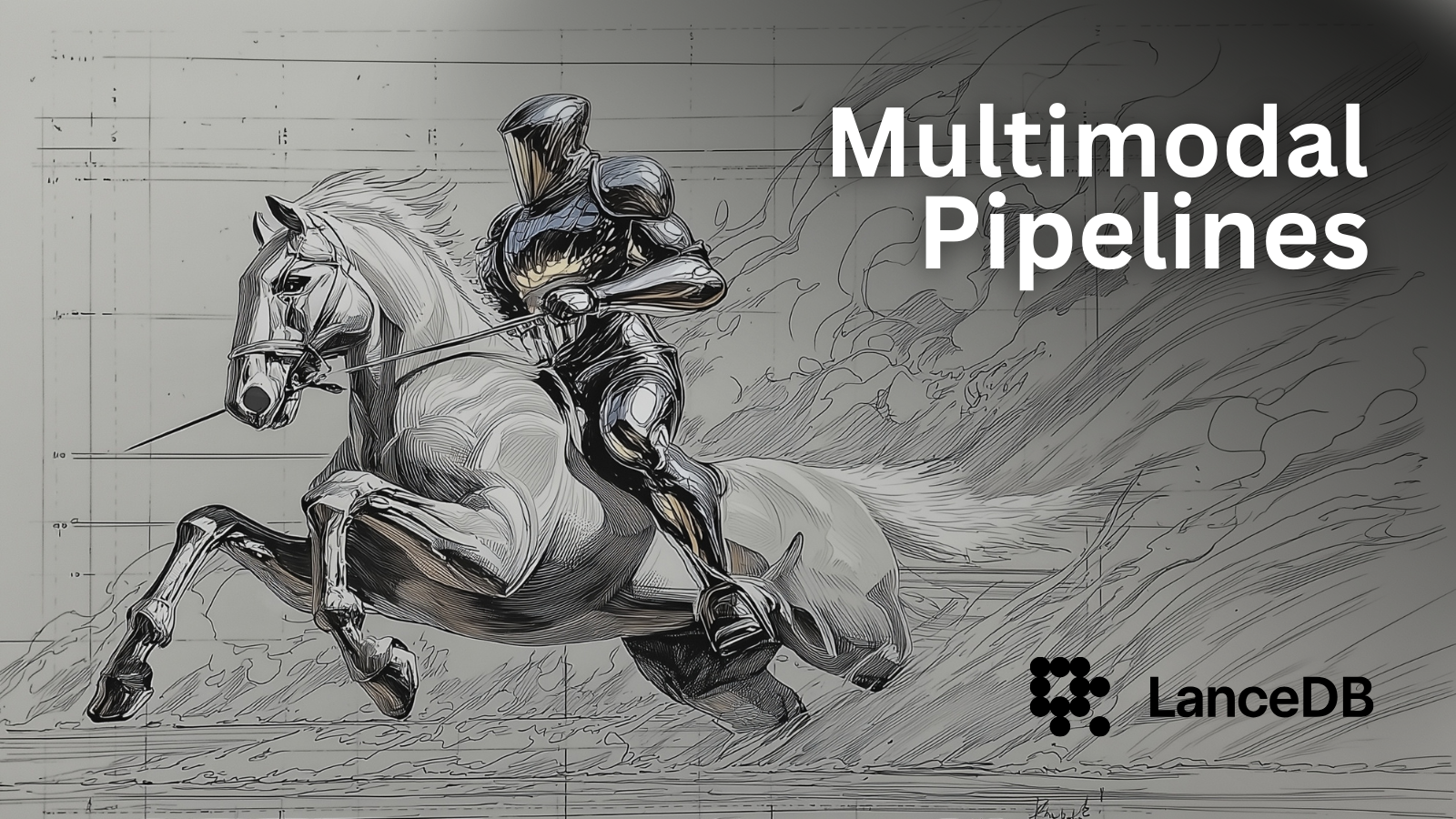In today’s world, video, audio, images, and text flow together in complex ways. Consider a news broadcast: the video stream shows anchors and visuals, the audio track carries speech and music, and the text layer might include captions or on-screen graphics.
Traditionally, building such pipelines meant gluing together object storage, relational databases, vector databases, and data warehouses. Each handled a piece of the puzzle, but the result was brittle and expensive to maintain. LanceDB’s multimodal lakehouse offers a more elegant alternative: a single place where raw data, embeddings, metadata, and analytics can all live together.
Why Multimodal Pipelines Matter
Multimodal pipelines unlock the ability to search and analyze media in ways that go far beyond keywords. Imagine asking the following question:
Find the moment where a dog barks while the subtitles say “open the red door.”
A traditional search system focused only on text would miss this completely. However, multimodal processing makes it possible. With LanceDB, you can connect sound, speech, and visuals together into one query.
This capability is not limited to search. Compliance teams want to detect when restricted logos or explicit language appears. Content platforms want recommendation engines that understand both what is said and what is shown. Analysts need tools to automatically summarize long-form video into digestible highlights. And machine learning engineers want to create training datasets where labels are drawn from multiple modalities at once. In every case, success depends on a pipeline that can align video, audio, and text without losing context.
Enter LanceDB’s Multimodal Lakehouse
LanceDB collapses this complexity into a single layer. Videos, audio, transcripts, and embeddings can all be represented in Lance tables.
The diagram below illustrates this unified architecture.

With Geneva UDFs, feature engineering happens inside the lakehouse. You can define how to compute features such as ASR transcripts or CLIP embeddings, and LanceDB will store them as columns in your tables. When models change, you can re-run and version features without losing consistency. Most importantly, the same data powers both production search and downstream analytics.
Because LanceDB is designed for petabyte-scale storage on object stores, it brings the scalability of traditional data lakes together with the performance of vector search engines. Instead of splitting your architecture into “hot” and “cold” paths, you get one system that does both.
Improvements Brought by LanceDB
The following table compares a traditional pipeline with a multimodal lakehouse across core aspects.
| Aspect | Traditional Pipeline | Multimodal Lakehouse |
|---|---|---|
| Storage | Your org’s files may end up scattered across object stores, relational databases, vector databases. | All org data is unified in a single Lance table that is versioned. |
| Feature Engineering | You need to build and maintain external ETL pipelines to connect all assets. | Geneva UDFs inside the lakehouse automate the tasks that maintain your Lance tables. |
| Consistency | There is a risk of misalignment between different data sources and their versions. | Lance tables keep your columns/features and their metadata always aligned and versioned. |
| Analytics | You may need a separate warehouse to examine all your data in one place. | LanceDB offers training, feature engineerg & analytics in one package. |
Building a Pipeline Step by Step
1: Ingest Videos
Start by registering video files in Lance tables. Each entry contains references to the raw files and essential metadata such as duration, resolution, and source. This provides a foundation that every subsequent step builds on. For example:
import lancedb
from datetime import datetime
db = lancedb.connect("s3://my-bucket/lancedb")
videos = db.create_table("videos", schema={
"video_id": str,
"uri": str,
"duration_s": float,
"fps": float,
"width": int,
"height": int,
"source": str,
"ingested_at": datetime
})2: Segment the Videos
Break each video into meaningful chunks—often by fixed time windows (like every 10 seconds) or by detecting scene changes. Segments become the atomic units for analysis, ensuring that search results point to precise moments rather than entire files. Segmentation also helps with scalability, since embeddings and queries operate at the level of short segments rather than full videos.
3: Extract Multimodal Features
For each segment, extract the signals that matter: frames for visual embeddings and object detection, audio for transcription and acoustic embeddings, and text from subtitles or OCR when available. By aligning all three modalities, each segment becomes richly described and semantically searchable. The result is a dataset where every time slice of video is annotated with multiple layers of meaning.
You can also take advantage of LanceDB’s built-in embedding functions. For instance:
from lancedb.embeddings import get_registry
registry = get_registry()
clip_emb = registry.get("open-clip").create()
# Example: encode a frame into an embedding
vector = clip_emb.encode_image("frame.jpg")This shows how you can easily generate embeddings for images using standard providers.
With Geneva UDFs, these extractions can be defined declaratively. For example, you can declare a column that automatically transcribes audio with Whisper and embeds the resulting text:
from geneva import udf
@udf(outputs={"asr_text": str, "text_embed": list[float]})
def transcribe_and_embed(audio_uri: str):
text = whisper_transcribe(audio_uri)
embedding = embed_text(text)
return {"asr_text": text, "text_embed": embedding}This keeps feature engineering inside the lakehouse rather than spread across external ETL jobs.
4: Store Features Together
Instead of scattering embeddings across systems, LanceDB keeps them in the same table alongside raw references and metadata. Every segment now has columns for start time, end time, transcription, visual embedding, audio embedding, and more. This design ensures that when you query, you’re always working with synchronized and consistent data.
Here’s an example of what a segments table might look like:
| video_id | ts_start | ts_end | asr_text | text_embed (dim=768) | clip_image (dim=512) | audio_embed (dim=256) |
|---|---|---|---|---|---|---|
| vid_001 | 0.0 | 10.0 | “open the door” | [0.12, 0.04, …] | [0.33, -0.08, …] | [0.11, 0.22, …] |
| vid_001 | 10.0 | 20.0 | “dog barking” | [0.02, 0.19, …] | [0.41, 0.10, …] | [0.55, -0.03, …] |
This illustrates how raw content (timestamps and transcripts) sits directly beside embeddings for text, visuals, and audio.
5: Index and Retrieve
Create indices over the embeddings so retrieval is fast. Because vectors and metadata live together, hybrid search feels natural. You can ask: “Find clips where the subtitles mention ‘red door’ and a barking sound is present in the audio.” The query touches multiple modalities in one place, and results can be filtered by episode, scene, or even detected objects.
segments.create_index(column="text_embed", metric="cosine")
results = segments.where(objects__contains="dog").search("text_embed", "red door", k=5)
for r in results:
print(r["video_id"], r["ts_start"], r["asr_text"])6: Analyze and Train
Beyond search, the same lakehouse powers analytics. You can query for balanced datasets, mine hard negatives, or sample examples for evaluation. Researchers and engineers can build training datasets directly from the same data that powers production, closing the gap between experimentation and deployment.
Benefits of the Lakehouse Model
The lakehouse model eliminates the need to manage fragile joins across multiple systems and ensures features and metadata are always aligned. Adding a new modality is as easy as creating a new column, and LanceDB’s design for large-scale storage means you can grow without worrying about duplication or migration pains.
Another important benefit is governance and observability. Because features are generated as columns inside the lakehouse, you can version them, track which model produced them, and monitor quality over time. This level of visibility is difficult to achieve when data is scattered across multiple systems.
Geneva UDFs and Simplified Feature Engineering
A key innovation in LanceDB’s multimodal lakehouse is the integration of Geneva UDFs (user-defined functions). These allow developers to define feature extraction directly as part of the table schema. Instead of building complex ETL pipelines that run externally and write results back, Geneva lets you declare that a column should be filled by a specific transformation—for example, running Whisper to transcribe audio, or CLIP to embed images. When new data is ingested, the functions run automatically, and when models are updated, recomputation is consistent and versioned. This approach removes a huge amount of pipeline glue code and ensures that feature engineering is scalable, traceable, and tightly coupled with storage. As a result, experimentation accelerates: adding a new embedding or feature is as simple as adding a new computed column.
For example, consider an audio track in a video segment. With Geneva UDFs you can define a column that automatically runs Whisper to generate a transcript, then another column that turns that transcript into a semantic text embedding. Both outputs are stored directly alongside the segment’s metadata and other modalities. If you later decide to switch to a newer speech model, you simply update the UDF definition and recompute. The entire process is transparent and versioned, ensuring reproducibility and eliminating the risk of stale or inconsistent features.
Multimodal Infrastructure, Simplified
Multimodal AI demands infrastructure that can keep pace. With LanceDB’s multimodal lakehouse, you can design pipelines that are cleaner, more maintainable, and more powerful. By treating video, audio, text, and metadata as first-class citizens in the same system, LanceDB makes it possible to build search engines, recommendation systems, monitoring tools, and training pipelines from a single source of truth.
In a world where AI must understand more than just text, multimodal pipelines are essential—and the lakehouse is the best way to build them.



